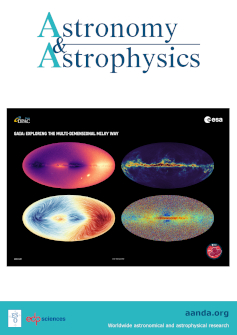X-Shooting ULLYSES:低金属性大质量恒星
IF 5.4
2区 物理与天体物理
Q1 ASTRONOMY & ASTROPHYSICS
引用次数: 0
摘要
背景。对大质量热恒星进行光谱分析是确定其内在特性和反馈的基本天体物理学方法。由于大质量热星具有固有的辐射驱动风,对其进行定量光谱分析需要对大气层进行详细的数值建模和迭代处理,以便在给定的框架内获得最佳解决方案。我们概述了 X-Shooting ULLYSES 合作项目中采用的不同热星定量光谱分析技术,包括基于网格的方法和量身定制的光谱拟合方法。通过对选定目标进行盲测,我们可以大致了解所得到的恒星和风参数之间的异同。我们的研究并不是对不同的代码或方法进行系统的基准测试;我们的目的是对不同方法造成的参数差异提供一个概览。对于XShooting ULLYSES样本中的三颗不同恒星(SMC O5星AzV 377、LMC O7星Sk -69° 50和LMC O9星Sk-66° 171),我们采用了不同的恒星大气代码(CMFGEN、Fastwind、PoWR)和不同的策略来确定它们的最佳拟合模型解。在分析中,我们使用紫外和光学光谱来推导恒星和风的特性,有些方法则纯粹依靠光学数据进行比较。为了确定整体光谱能量分布,我们还进一步采用了文献中的其他光度测量方法。三个不同样本恒星的有效温度相差在 3 千卡以内,而对数 g 的差异可达 0.2 dex。由于红化假设不同,光度差异可达 0.1 dex,而采用遗传算法的方法的光度差异似乎更大。所有样本恒星都富含氮。末端风速惊人地相似,并不严格遵循u∞-Teff关系。我们发现不同方法得出的恒星和风的参数具有合理的一致性。量身定制的拟合方法往往能够最大限度地减少或避免较粗或越来越自动化的处理方法所产生的差异。包含紫外光谱数据对于确定现实的风参数至关重要。对于一个目标(Sk -69°50),我们发现了明显的演化状态迹象。本文章由计算机程序翻译,如有差异,请以英文原文为准。
X-Shooting ULLYSES: Massive stars at low metallicity
Context. The spectral analysis of hot, massive stars is a fundamental astrophysical method of determining their intrinsic properties and feedback. With their inherent, radiation-driven winds, the quantitative spectroscopy for hot, massive stars requires detailed numerical modeling of the atmosphere and an iterative treatment in order to obtain the best solution within a given framework.Aims. We present an overview of different techniques for the quantitative spectroscopy of hot stars employed within the X-Shooting ULLYSES collaboration, ranging from grid-based approaches to tailored spectral fits. By performing a blind test for selected targets, we gain an overview of the similarities and differences between the resulting stellar and wind parameters. Our study is not a systematic benchmark between different codes or methods; our aim is to provide an overview of the parameter spread caused by different approaches.Methods. For three different stars from the XShooting ULLYSES sample (SMC O5 star AzV 377, LMC O7 star Sk -69° 50, and LMC O9 star Sk-66° 171), we employ different stellar atmosphere codes (CMFGEN, Fastwind, PoWR) and different strategies to determine their best-fitting model solutions. For our analyses, UV and optical spectroscopy are used to derive the stellar and wind properties with some methods relying purely on optical data for comparison. To determine the overall spectral energy distribution, we further employ additional photometry from the literature.Results. The effective temperatures found for each of the three different sample stars agree within 3 kK, while the differences in log g can be up to 0.2 dex. Luminosity differences of up to 0.1 dex result from different reddening assumptions, which seem to be systematically larger for the methods employing a genetic algorithm. All sample stars are found to be enriched in nitrogen. The terminal wind velocities are surprisingly similar and do not strictly follow the u∞−Teff relation.Conclusions. We find reasonable agreement in terms of the derived stellar and wind parameters between the different methods. Tailored fitting methods tend to be able to minimize or avoid discrepancies obtained with coarser or increasingly automatized treatments. The inclusion of UV spectral data is essential for the determination of realistic wind parameters. For one target (Sk -69° 50), we find clear indications of an evolved status.
求助全文
通过发布文献求助,成功后即可免费获取论文全文。
去求助
来源期刊

Astronomy & Astrophysics
地学天文-天文与天体物理
CiteScore
10.20
自引率
27.70%
发文量
2105
审稿时长
1-2 weeks
期刊介绍:
Astronomy & Astrophysics is an international Journal that publishes papers on all aspects of astronomy and astrophysics (theoretical, observational, and instrumental) independently of the techniques used to obtain the results.
 求助内容:
求助内容: 应助结果提醒方式:
应助结果提醒方式:


